German ecommerce marketplaces navigation – infrastructure survey

In this review, we scanned six major German ecommerce marketplaces navigation systems and focused on the navigational infrastructure for the 3 categories in each of them: Women’s T-Shirts, Women’s Boots, and Smartwatches
In previous blog posts we talked about the importance of site navigation to ecommerce websites. In this article we are going to review several major online retailer websites, and see how they have structured their sites to accommodate customers and provide them with a good user experience.
In this review, we scanned six major German ecommerce marketplaces navigation systems and focused on the navigational infrastructure for the 3 categories in each of them: Women’s T-Shirts, Women’s Boots, and Smartwatches. We will look into the basic filters, facets and respective values in each one of the sites and categories.
Amazon.de
Amazon, as expected from such a major retailer, has a very well-structured navigation infrastructure. The filters they offer for all the product categories we reviewed were practically the same. Customers can filter out results based on Price, Customer Reviews, Condition (new or used) and Sellers. In addition, there are filters that help users locate popular brands, new products (from last week, last month or the last 3 months), and special deals.
However, the “Availability” filter, which displays only products that are currently in stock, only appears in the Women’s Boots and Smartwatches categories. We could not find a good reason as to why Amazon did not include this filter in the Women’s T-Shirts category as well.
Amazon does a good job in the attributes it offers. The attributes for each of the categories we reviewed changed with each product to reflect its characteristics. Browsing the Women’s T-Shirts category, you will find the usual Size, Brand, Color and Material attributes, each offering a fair amount of values to choose from. Amazon also offers users to refine the results according to shirt pattern and to multipacks of several shirts. Stil, there are some relevant attributes that are missing from this category, such as Sleeve Length, Fit and Collar Shape.
In the Women’s Boots category we can also find the Size, Brand, Color and Material attributes, alongside such very relevant attributes such as Leg Width and Length, Heel Type and Height and Closure Type.
In the Smartwatches category, however, the attributes are nowhere near enough. While offering the same filters as the other categories, the attributes in the Smartwatches category only include a Feature attribute (offering GPS, calendar, camera, voice control and alarm) and a Brand attribute. Not only are these the only attributes available, but the values they offer are quite poor. The features are not close to covering all the function of a basic smartwatch, and the brand attribute is missing most of the most popular brands.
Ebay.de
Ebay is another good example of a well-structured navigation infrastructure, but still not perfect. The filters Ebay offers are uniform throughout the three categories we reviewed, and are Ebay Plus (which filters special deals), Condition (new or used), Price, Item Location, Sellers and Delivery Options. We have already seen that Ebay has much more variety than Amazon, but it will come back to bite them, as you shall see.
Regarding attributes, in the Women’s T-Shirts category, Ebay offers its customers the following attributes: Size, Color, Brands, Material, Pattern, Sleeve Length, Collar, Fit, Occasion, Style and Season. In comparison to Amazon (and the rest of the site we reviewed), Ebay offers the largest variety of attributes. Moreover, each of the attributes contains plenty of different values, thus increasing the chances that users will find exactly what they are looking for.
But more content requires more attention, and if you load up your navigation infrastructure with attributes and values, you increase the chances of errors and redundancies. Such is the case with the Collar attribute, which offers two different values for “Rounded neckline”.
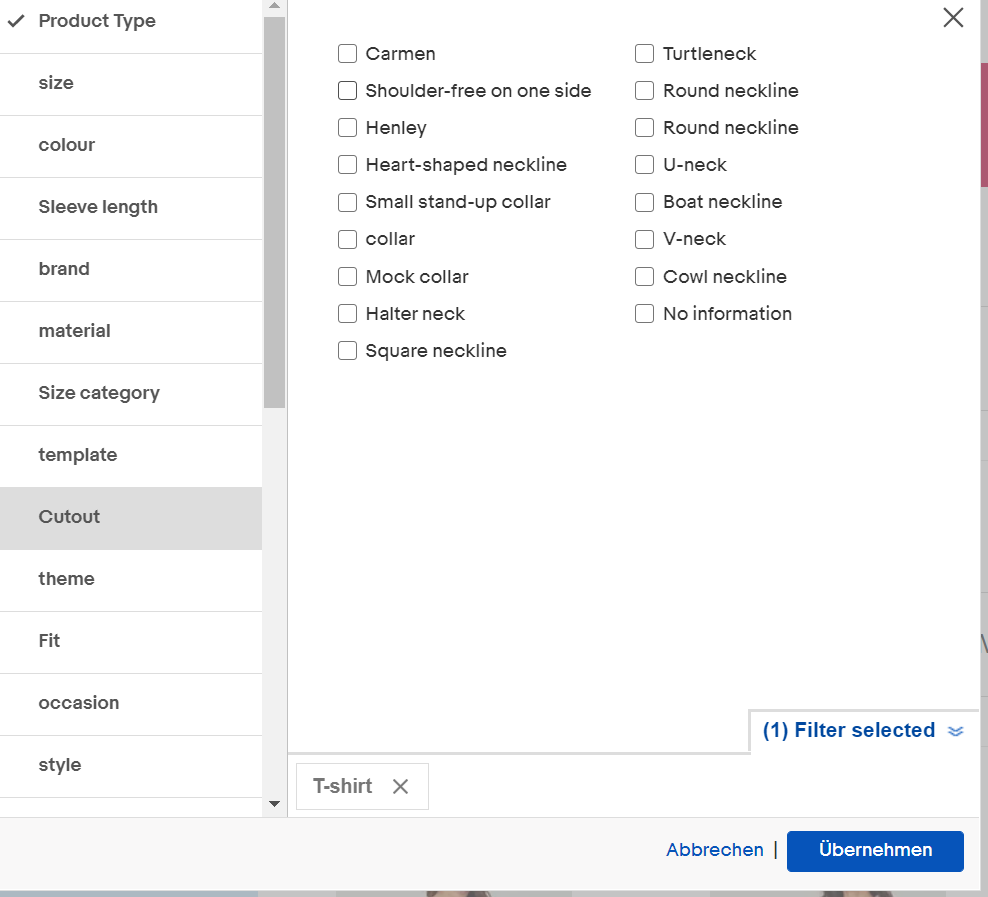
The Women’s Boots category also offers plenty of relevant attributes. Beyond the Size, Brands, Material and Color attributes, there are also Heel Type and Height, Style, Occasion, Season and Closure attributes, which offer plenty of different values to choose from.
The Smartwatches category on Ebay is better than Amazon’s, but has its own problems. Not only it offers much more attributes than Amazon, such as Case Size, Operating System, Storage, Material and Armband Color, but also each attribute, including Brands and Features, offers a variety of values that Amazon just does not.
Where Ebay missteps is their Series and Model attributes, which are basically the same attribute, containing almost the same values.
Otto.de
This online retailer offers its customer the following filters: Price, Seller, Customer Reviews, Special Deals and Sustainability. While the Women’s T-Shirts and Boots share these filters, for some unknown reason, the website decided not to include the Customer Reviews filter in the Smartwatches category.
In the Women’s T-Shirts category, customers are offered the following attributes: Size, Color, Sleeve Length, Brands, Neckline/Collar, Pattern, Style and Age Group. As in Ebay, the attributes contain many values to choose from, but while Ebay were able to keep the redundancies to a minimum, Otto did a bad job. Almost every attribute contains redundant values. For example the Collar attribute contained both “round neck” and “round collar” values, and the Style attribute contains several of “casual” values, not to mention the strange “stylish” value. This is also true of the Pattern attribute, with its multiple “striped/Striped/stripe” values.
In the Women’s Boots category, customers are offered the following attributes: Size, Color, Brands, Heel Height, Material, Width, Inner Materials, Toe Shape, Outsole Profile, Style, Age Group and Season. As in the T-Shirts category, the richness of content comes at cost, and there are many errors and duplication. For example, the Material attribute contains two “synthetic” values, while the “classic” value in the Style attribute is repeated several times. If you want to get a glimpse at what too much content might create, just look at the Inner Materials Attribute:
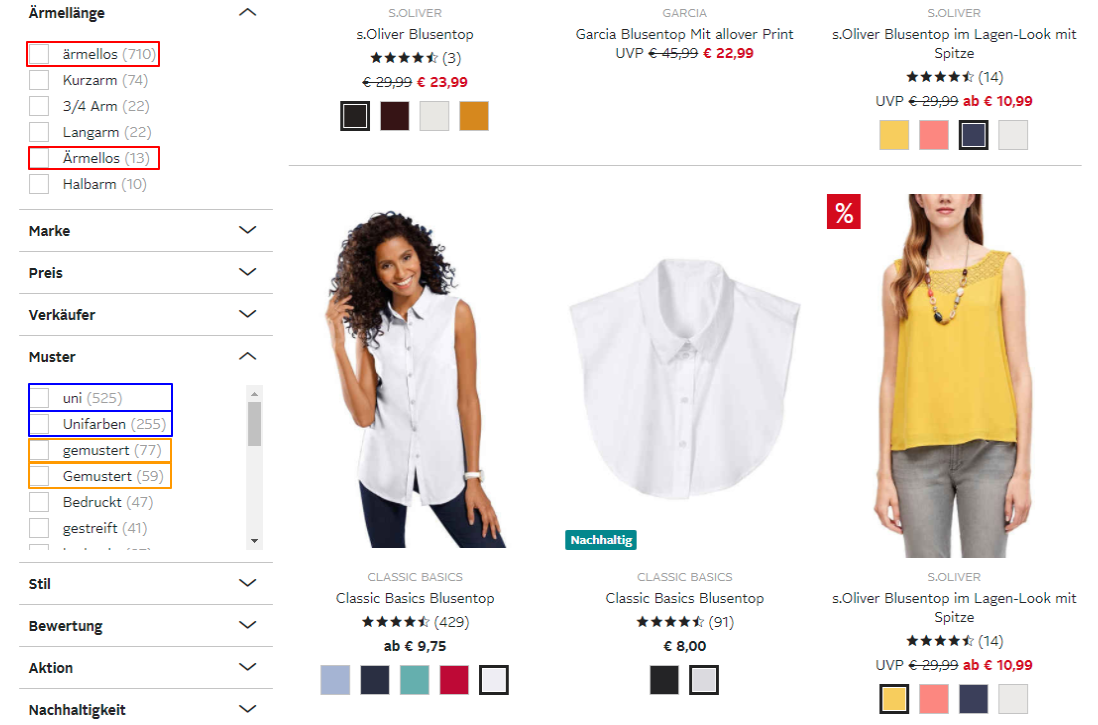
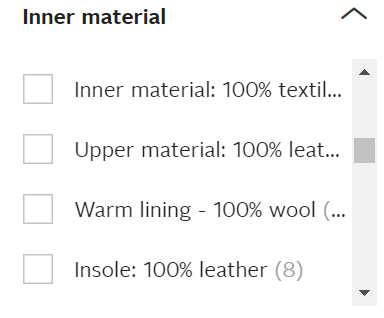
An incomprehensible mixture of irrelevant values (upper material???) and plenty of repetitions and redundancies.
The attributes in the Smartwatches category are varied and relevant: Brands, Services (long term guarantee), Features, Color, Shape, Protection, Compatibility and Model Series.
Where Otto smartly combined the Model and Series attributes (unlike Ebay), they did not manage to make the Shape attribute (offering two “round” values, and two “agular”) really useful, and the Compatibility attribute contains many redundancies.
Zalando.de
The filters offered by Zalando are: Price, Sustainability, Deals and Delivery Method. These are decent filters, but the Sustainability and Deals are missing from the Smartwatches category.
The attributes are reflective of the category reviewed, but are few in numbers, relative to the other sites we reviewed. In the Women’s T-Shirts category the customers are offered the Size, Color, Brands, Material, Specials Size, Season and Style attributes. While some important attributes, such as Sleeve Length and Collar, are missing, other attributes contain strange values, such as the “sweat” value under the Material attribute.
In the Women’s Boots category we find a nice variety of attributes, such as Heel Type and Height, Toe Shape, Leg Width and Length, Lining, Closure and a surprising Vegan attribute, for all natural boots. Here we were also able to find some redundant values, such as two “platform” values under the Heel Type attribute.
Zalando sells less than 20 smartwatches, so there is no surprise its Smartwatches category is lacking. The only attributes offered here are the Brands and Color attributes. But since the number of products on sale is so low, there is no need for a more detailed navigation here.
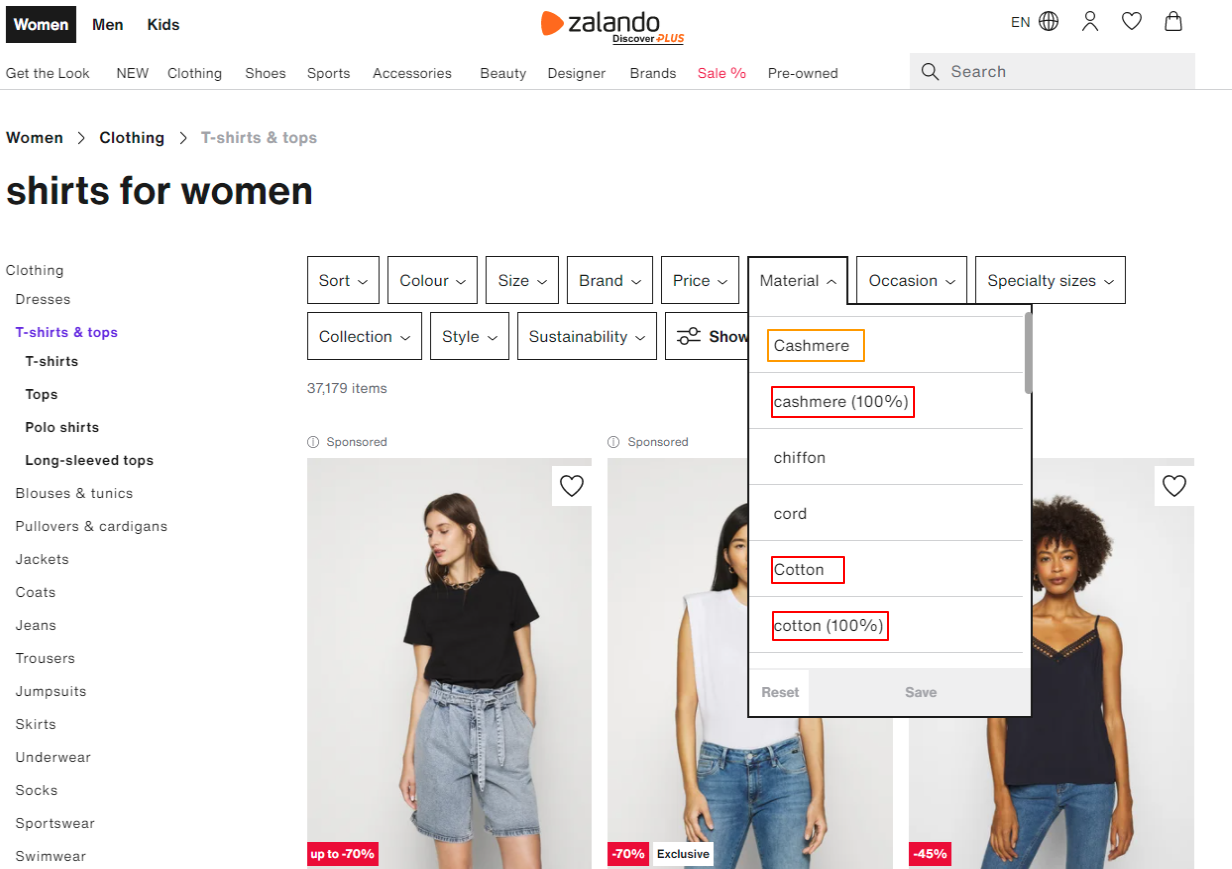
Real.de
Real offers a couple of basic filters throughout the website: price and frequently searched keywords in the category in which you are currently searching. For example, when searching for a smartwatch, the website offers you such keywords as Garmin Vivofit, Samsung Gear and more.
In the Women’s T-Shirts category, customers are only able to refine the results using the basic Size, Brands and Color attributes. There is a Target Group attribute, but since we initially went to the Women’s Clothing department, this attribute is not necessary at this point.
The Women’s Boots category offers the same attributes, with the single addition of Heel Height attribute. We know many relevant attributes are missing here as well. The poor variety continues into the Smartwatches category, where customers are offered only the Color and Brands attributes, in addition to the Battery attribute which determines whether the watch has batteries or not. Compared to the other websites we visited, the attributes selection here is terribly poor.
Yatego.com
Among German ecommerce marketplaces navigation systems one stands out. After all our discussions about the advantages of site navigation, it is really surprising to see ecommerce marketplace with a system like on Yatego.com Why? Other than sorting the results by price or popularity, the site offers no filters or attribute at all. In fact, there is no navigation tool to be found. The only information the site provides is which category you are currently in, and frequently searched tags, that are mostly unhelpful at all (for instance, only XXL tags are available).
So how do you navigate through the results? Just as you would an actual brick and mortar store: their result page contains every product in the category (including different pages for each size of the same product) and it is up to the seller to browse through the entire inventory. Even when you find a shirt to your liking, you still have to go through all the results, and find the one with the correct size.
After getting used to site navigation, the lack of it is so glaring, and leaves the customer extremely frustrated.
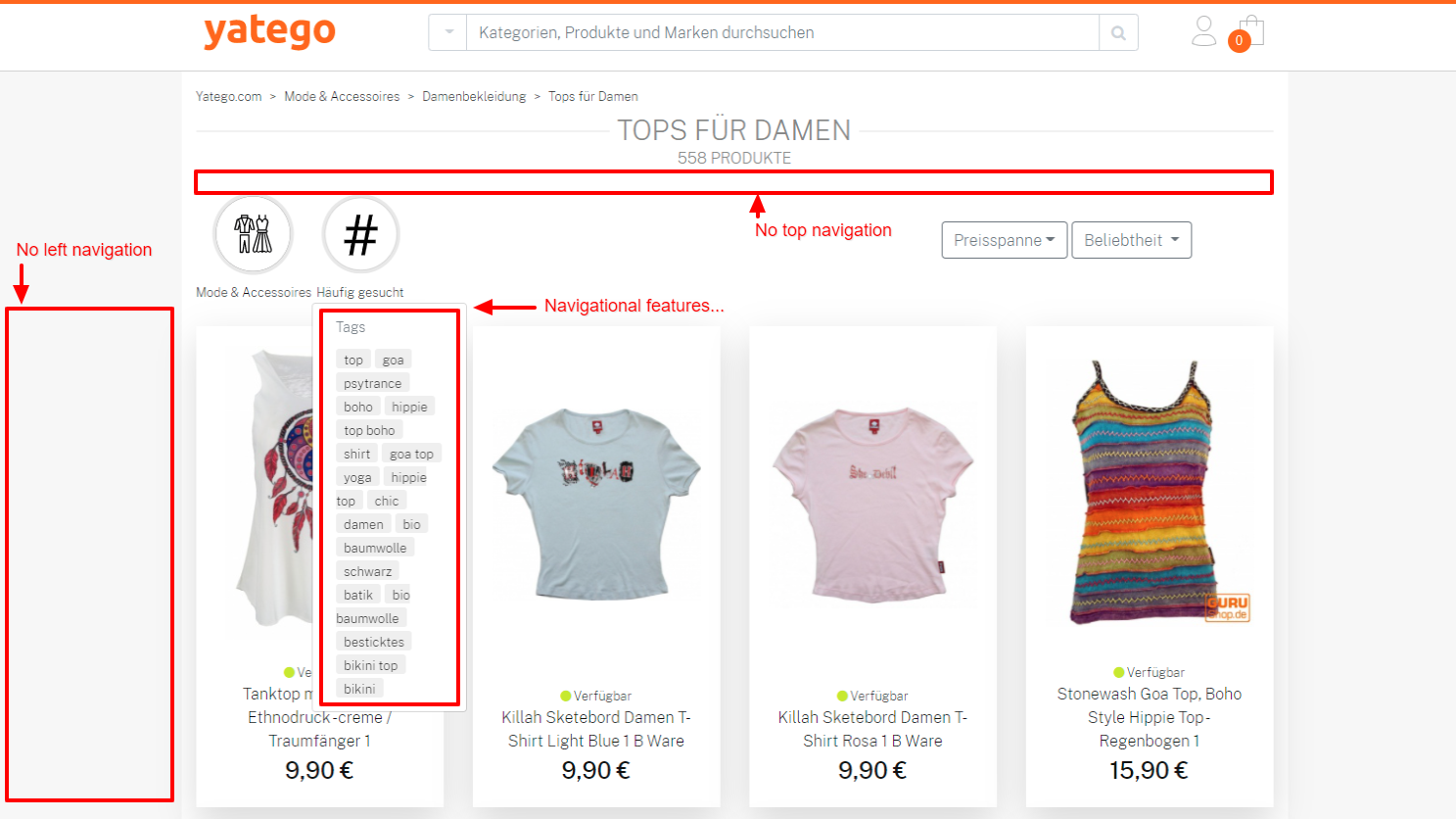
After surveying German ecommerce marketplaces navigation, join us next week when we will review the navigation precision in each marketplace.




